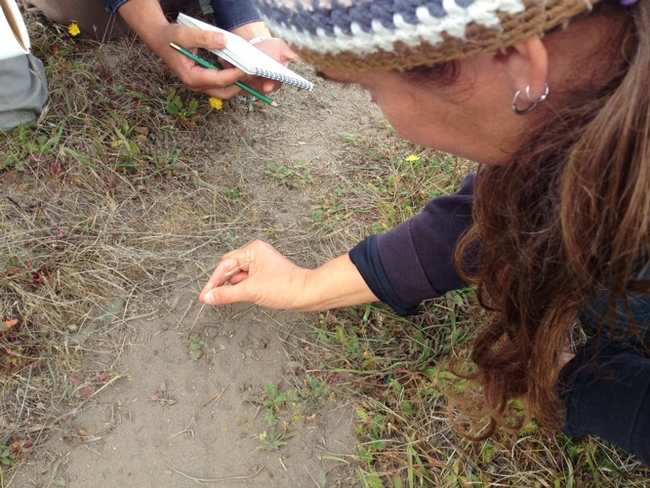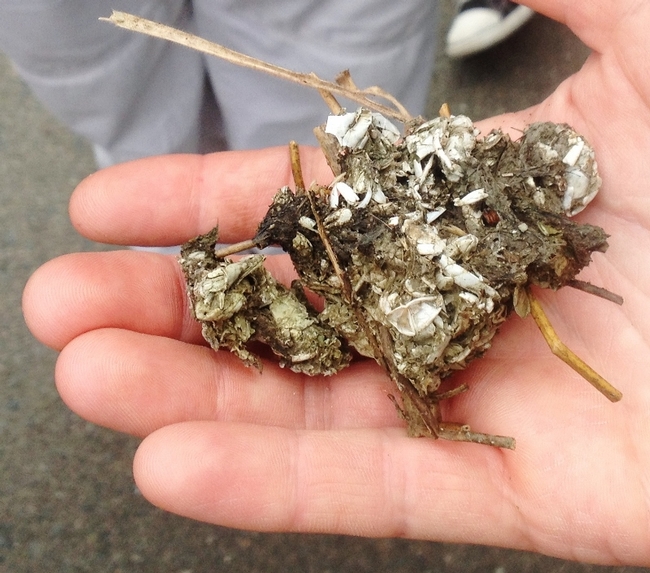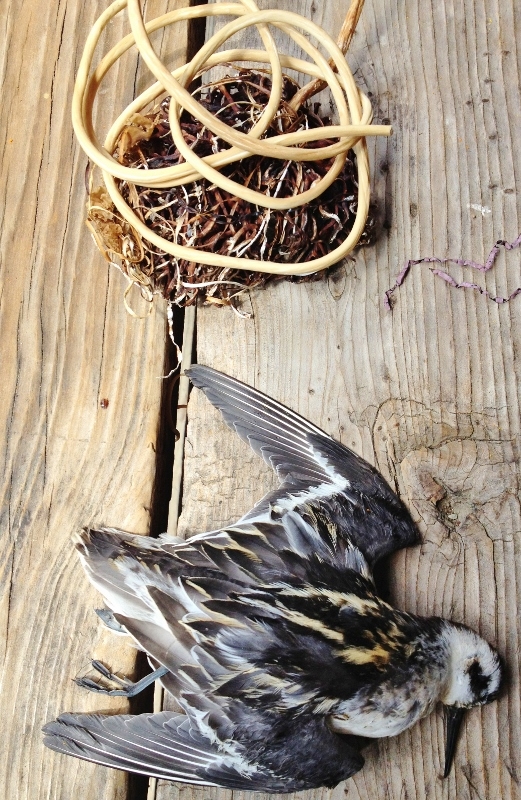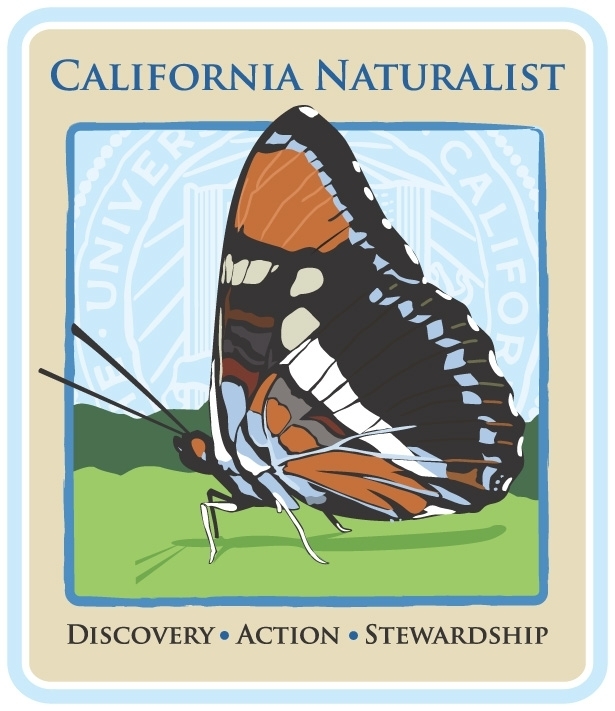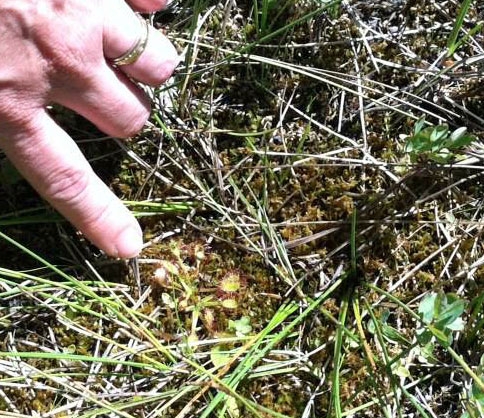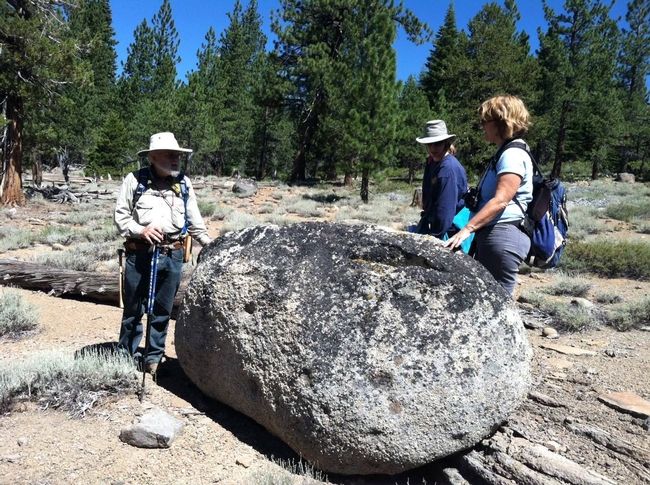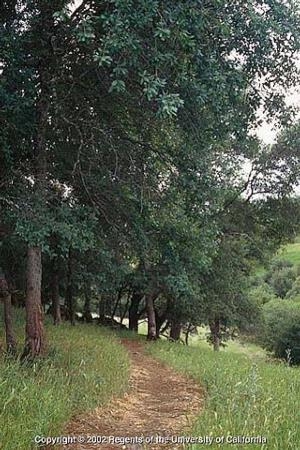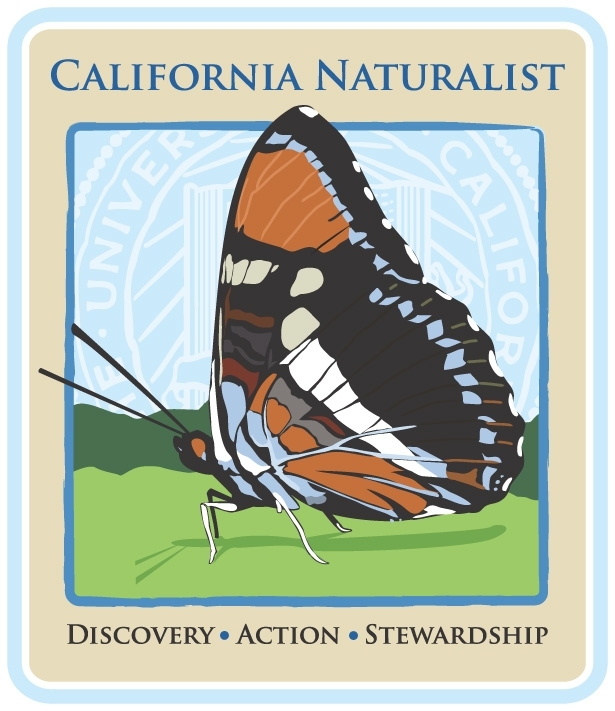Posts Tagged: California Naturalist
Time spent learning about nature in the outdoor classroom is irreplaceable
On a recent misty coastal morning, a group of 25 adults formed a circle on the beach in front of the UC Davis Bodega Bay Marine Lab. We sat cross-legged with our field journals in our laps, toes digging into the cold damp sand and jackets zipped up tight to keep out the salty breeze.
Our circle was comprised of young and old, men and women, educators and students, budding and seasoned naturalists alike. We were all paying close attention to our UC California Naturalist instructor from Occidental Arts & Ecology Center who was unraveling the mysteries of animal tracks and sketching them for our benefit in a large field journal. She was setting the stage for our morning activity: to explore the sand dunes for animal sign. As we took copious notes, she described the wide diversity of animals that might use the rocky intertidal areas, sandy beaches, lagoon mudflats, tidal saltmarshes, sand dunes, coastal bluffs, coastal scrub, and freshwater wetland communities that occur in the near vicinity. She demonstrated how we could discern which was a front or hind foot track, left or right side, why and how one might determine what the animal was doing in that location, and more. She left some questions unanswered, encouraging us to explore, observe, draw, and discuss what we found. She told us to share our observations and piece together the stories, so off we eagerly hiked to explore animal sign.
In less than an hour we found raccoon, deer, and myriad bird tracks, nibbled vegetation, an endangered red-legged frog, a recently deceased shorebird called a phalarope, and a large handful of shell-filled river otter scat. We saw seabirds, waterbirds, passerines, and raptors fly by. The entire class was elated when we re-convened in the parking lot to share our observations.
As I chatted with California Naturalist Program Director Adina Merenlender, UC Cooperative Extension specialist in the Department of Environmental Science, Policy and Management at UC Berkeley, on the windy road back to Occidental, we came to the conclusion that not only had we immensely enjoyed a morning outside, recorded some amazing discoveries, and accomplished a site visit with a new partnering institution, we felt like we needed the time out in the nature.
We discussed the term “nature deficit disorder” coined by Richard Louv, author of Last Child in the Woods, which points to a modern issue of the broken bond between children and nature as a cause of the rise in childhood obesity, attention disorders and depression. Louv asserts that a “growing body of research links our mental, physical, and spiritual health directly to our association with nature — in positive ways . . . we can now assume that just as children need good nutrition and adequate sleep, they may very well need contact with nature.”
Dr. Merenlender and I reaffirmed that time spent in nature as adults can also serve the dual purposes of educating and soothing maladies. Indeed, on this outing exploring the dunes we managed to learn about the local area while invigorating ourselves and alleviating the recent stress of rigorous professional and personal schedules!
Data from the first two years of UC California Naturalist Program evaluations support our theory that time in nature is productive and energizing for students.
California Naturalist Program staff and Directors firmly believe that formal classroom time paired with valuable time spent learning in nature allows this successful program to flourish and fosters a diverse community of naturalists that promote stewardship of California's natural resources.
Blossoming California Naturalist program generates new stewards of the earth
| Walter Clevenger, left, checks the feathers of a robin. California Naturalist Jen Cubias records data. |
Before dawn at UC’s Sagehen Creek Field Station north of Truckee, wildlife biologist Walter Clevenger sets up almost invisible nets to capture birds rising from their roosts.
After measuring their wings and gently blowing aside the feathers on their tiny pink abdomens to determine gender and general health, Clevenger sets the birds free. All the data is recorded by California Naturalist Jen Cubias.
California Naturalist Kaitlin Backlund of Truckee visits the 450-acre station several times a week. She trains volunteers to monitor plants, animals and insects at the site using the phone app/website iNaturalist.
Both Cubias and Backlund were members of Sagehen’s first class of California Naturalists, who were certified in 2012. Another 10-week class is underway at Sagehen this summer and an intensive one-week class was held July 8-14. California Naturalist classes are being offered by University of California Cooperative Extension and collaborating organizations up and down the state, including Santa Barbara, Santa Cruz, Sonoma, Mendocino, Santa Ana and Pasadena.
The program champions the state’s unique ecology and engages volunteers in stewardship and study of California’s natural world. A love of nature and a desire to share their passion prompt people to commit time to becoming and serving as California Naturalists.
California Naturalist is modeled after other successful volunteer outreach programs sponsored by UCCE. The Master Gardener program was launched in 1980; the Master Food Preserver program, also in place since the 1980s, has recently seen a dramatic resurgence in interest. The California Naturalist program uses a science curriculum, hands-on learning and volunteer service to inspire stewardship of the state's parks, wetlands, coastal areas, mountains, foothills and forests.
Forest ecology is a natural for the Sagehen Creek course. The woods of the Sagehen Creek watershed were clear cut in the late 1800s to build the Transcontinental Railroad and shore up mines in Virginia City, said Sagehen director Jeff Brown.
Trees grew back, but the suppression of intermittent fires that under natural circumstances create a diverse forest environment with sugar pine, Jeffrey pine and ponderosa pine instead favors dense stands of white fir and underbrush, which could fuel a catastrophic fire.
“It’s time to do something,” Brown said.
Brown is working with Scott Conway, vegetation management officer with the U.S. Forest Service Truckee Ranger District, to employ a complex management system in the Sagehen basin that takes into consideration wildlife needs, slope, aspect, ridges and drainages to establish locations for prescribed burning, discontinuous logging and smart planting.
“According to computer models, these treatments will work like speed bumps for fire,” Conway said. “We’ll also be encouraging a return to Sagehen’s natural forest diversity.”
Mike Hamilton, a lifelong naturalist and director of UC’s Blue Oak Ranch Reserve in Santa Clara County, took Sagehen’s aspiring naturalists on a botany tour of the station. With the diversity of plants to view, the group didn’t go far.
“A typical botany walk is 100 inches, and then the day is over,” Hamilton said.
Blooming wildflowers in July included Ranger’s buttons, royal penstemons, Sierra tiger lily and columbine, but the highlight was tiny red round-leaved sundew hidden among the grasses, rushes and sedges of the fen. A saturated meadow, a fen is something like a bog, in that soil chemistry inhibits decomposition so organic material builds up. However, it is on a slope so water continuously flows through.
The sundew is a native carnivorous plant with prickly leaves that emit a sticky liquid, trapping tiny insects for food.
“It’s the coolest plant in the Sierra Nevada,” Hamilton said.
A session on wildlife included hands-on viewing of preserved wild animals that are found at the station, including bats, shrews, mountain lions, beavers and flying squirrels. During a water monitoring session, naturalists analyzed water samples to determine the dissolved oxygen, nitrate level and alkalinity in Sagehen Creek.
Retired U.S. Geological Survey geologist Gary Raines and UC Santa Barbara geology professor Art Sylvester focused the class’s attention on the primeval history of the watershed, which requires a completely different view of the environment. The soil in the area is primarily composed of andecite, a dark volcanic rock about 6 million years old.
“This valley was here at least 5 million years before Yosemite Valley was formed,” Raines said. “But it wasn’t 7,000 feet high back then.”
During a geology walk, Raines asked the group how a several million-year-old and very large granite boulder could be found on top of the much younger andecite deposit.
“Probably a glacier,” he said.
Learning about nature is critical for California Naturalists, but learning to interpret nature is equally important. The program prepares its volunteers by introducing the iNaturalist.org website/app for cataloging observations of plants, insects and wildlife into a database that can be used for scientific research. The aspiring naturalists also learn about interpretation of nature through art – such as storytelling, journaling, photography and drawing.
“Interpretation involves making meaning and forming connections, not just rattling off facts,” said Laura Cassidy Rogers, a doctoral student in modern thought and literature at Stanford University. “Let the natural world be your guide. Capitalize on happenstance sightings and zero in on what your constituents find interesting.”
All participants conduct a “capstone project” to complete California Naturalist certification. The capstone encourages the naturalists to apply their new skills by taking part in citizen science, offering interpretive opportunities to the public, providing program support to their sponsoring organizations or conducting stewardship work that benefits the California natural environment. To learn more, see the California Naturalist website.
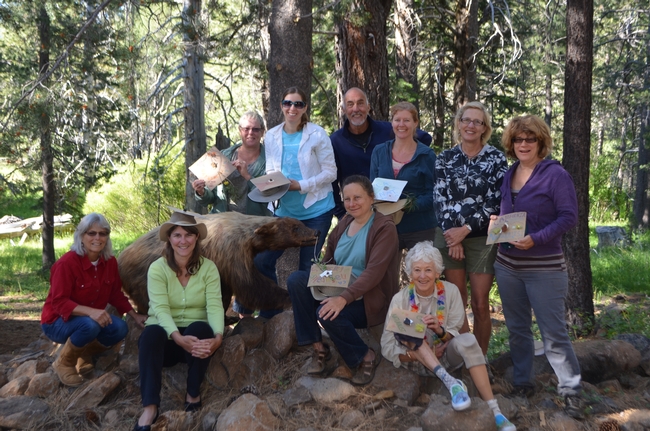
Teacher Leslie Smith (left) poses with the nine new California Naturalists who completed one-week of intensive training on July 14.
Interest growing in UC's California Naturalist Program
The California Naturalist Program is a statewide initiative of UC Cooperative Extension. The program is aiming to create a diverse community of naturalists and promote stewardship of California's natural resources through education and service. Once certified, the naturalists will have a background about California's unique natural treasures and tools for communicating that knowledge to other people.
The 40-hour California Naturalist training course combines classroom and field experience in science, problem-solving, communication and community service. Students are taught by experts on the topics of ecology, geology, plant communities, interpretation, wildlife, energy, and others.
Recent newspaper accounts include:
- California Naturalist Program offers learning, with a huge dollop of fun
Jackie Pascoe, The Santa Cruz Sentinel - California Naturalist Training to be offered at Sagehen Creek
Tahoe Daily Tribune - Naturalists in training
Justine Frederikson, The Ukiah Daily Journal
The California Naturalist Program was also featured in a 30-minute broadcast on Radio Curious called "You Too May Be a Naturalist." Adina Merenlender, UCCE specialist in the Department Environmental Science, Policy and Management at UC Berkeley and co-founder of the California Naturalist Program, and Deborah Edelman, co-author with Merenlender of the California Naturalist Handbook, spoke about the development and goals of the program.
During the broadcast, Edelman and Merenlender explain the concept of "citizen science," how it fits in with the California Naturalist Program, what it means for the future of nature research, and its potential impact on the long-term viability of the state's natural environment.
California Naturalist Program grows a new constituency for nature
Have you heard of the UC ANR California Naturalist Program? This new UC ANR program fosters a diverse community of naturalists and promotes stewardship of California's natural resources through education and service. Designed to introduce Californians to the wonders of our unique ecology and engage volunteers in stewardship and study of California’s natural communities, California Naturalist provides hands-on instruction and exposure to real world environmental projects designed to inspire adults to become active citizen scientists and enhance their personal connection with the natural world.
The California Naturalist Program encourages Californians to help protect and preserve our unique and diverse wildlife, habitats, rivers, lakes and coastal resources, wild and urban alike. Currently, the program certifies naturalists through 10 partnering institutions statewide, and continuing education units/college credit are available. Becoming a California Naturalist is a commitment to life-long learning. Advanced training opportunities for naturalists are continually offered by California Naturalist partners and the University of California. The program is in the planning stages for a first bi-annual statewide conference in 2014.
California Naturalist’s newest course offerings include two summer 2013 in-residency intensive courses at Nevada County’s UC Berkeley Sagehen Creek Field Station (July 8 - 14, 2013) and Sonoma County’s Occidental Arts & Ecology Center (August 15 - 22, 2013). These residential summer courses provide a chance to immerse yourself in the wonders of California’s unique ecology. Through a combination of science curriculum, guest lecturers, field trips and project based learning, participants will advance their ability to observe and understand nature. Great for teachers, docents, environmental professionals, and everyone interested in natural history.
Please learn more about taking a class or becoming a partnering institution on the website, find us on Facebook or contact us directly at canaturalist@ucanr.edu or (707) 744-1424 Ext. 104.
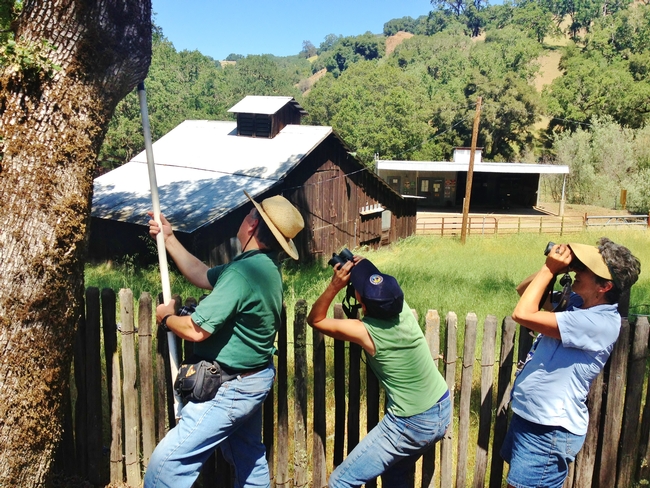
California Naturalists in-training participate in NestWatch, a nationwide monitoring program designed to track status and trends in the reproductive biology of birds.
California Naturalists training at UC research center
The nearly 30-member 2013 class of California Naturalists in Mendocino County participated in a field day Saturday at the UC Hopland Research and Extension Center, reported the Ukiah Daily Journal.
The University of California's California Naturalist program aims to host courses around the state to train outdoor enthusiasts on a variety of topics, such as plants, animals, water resources and geology. The Mendocino Program focuses on the local mixed oak woodland.
"The goal of the program is to create a group of stewards of our lands and water resources," said Deborah Stanger Edelman, the course's lead instructor. "To give people a background on what is unique about California, and also provide the tools for communicating that knowledge to other people."


